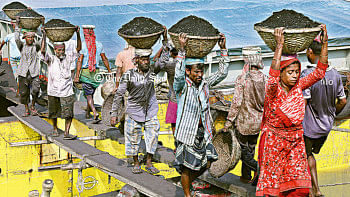Work force dividend to last 16 more years
Bangladesh's opportunity to seize the benefits of 'demographic dividend' will last for the next 16 years as there will be an acceleration in numbers of elderly people (60 years and above) after 2031.
The period till 2031 represents the optimum time for investing in human resources and establishing other enabling conditions for economic growth in Bangladesh, says a government-commissioned study report to be made public today.
Demographic dividend is defined as the economic growth potential that can result from shifts in a population's age structure, mainly when the share of the working-age population (15-59 years age) is larger than those of the non-working-age share. Such a scenario helps a country to cut spending on dependents and spur economic growth.
General Economics Division (GED) of the Planning Commission prepared the 'Demographic Impact Study' (DIS) report as part of its preparation to map out the 7th Five Year Plan (FY 2015-16 to FY 2019-20).
Noting that Bangladesh will “grow old before it grows rich”, the DIS suggests "this is something to be planned for rather than feared."
"Taking advantage of the demographic dividend is an urgent imperative for Bangladesh. The dividend is not automatic; it is achieved only if the appropriate policies and development strategies are pursued," reads the report.
New population projections were prepared specifically for this report. The projections cover a period up to 2061 and it says population may potentially reach 265 million by then from 156 million now.
According to the DIS, the most dramatic change to be expected in future is the increase in the elderly population, defined conventionally from the age of 60 and over. It says the number of elderly would increase by five times, from 11.2 million in 2011 to 55.7 million in 2061.
"Given that the labour force will be growing at a much slower rate than the elderly population in future, the number of workers per elderly person will decline. Between 2011 and 2031, the number of working age persons per elderly person will decline from 7.7 to 5.9, and by 2061 between 2 and 3," DIS projects.
It says the period during which the proportion of the working-age population will increase relative to other age groups, provides a one-time “window of opportunity” for investing heavily in human resource development. But after 2031 as the population ages further, the dependency ratio will increase and the “window” will gradually close and the demographic dividend will no longer be available.
The expected changing age structure of population in Bangladesh will increase the pressure on the State to increase the allocation of funds to support the elderly. Currently, around 28 percent of the population aged 60 years and above are living below the national poverty line, while many older people are close to the poverty line and therefore vulnerable.
The country's current dependency ratio is 58 or in other words, there are 100 working-age people in Bangladesh for every 58 elderly people today. Till 2031 Bangladesh can potentially reap the benefits of demographic dividend as dependency ratio is expected to decline to 43 by then (2031). But afterwards, the dependency ratio would increase again, the report says.
DIS expects that by the time ageing reaches high levels in Bangladesh, those becoming elderly will be better educated and healthier and with a much higher level of economic development than at present, making more resources available.
But the situation will be manageable, the report says, "only if good use has been made of the intervening period, in terms of raising income levels, developing programs of active ageing, introducing appropriate income support programs and modifying health systems to adjust to the altered pattern of both communicable and non-communicable disease and disability resulting from a rising proportion of elderly in the population."
At present, only 10 to 24 percent of the poor receive Social Safety Net Program (SSNP) benefits, and "these schemes also suffer from misallocation, fraud and corruption. Ways need to be found of improving targeting and increasing coverage of the poor, within the fiscal capabilities of the Bangladesh government."
The GED and the UN Population Fund (UNFPA) will jointly launch the DIS report today on the concluding day of the two-day meeting on "South-South and Triangular Cooperation in the Post-2015 Development Agenda: Financing for Development in the South and Technology Transfer."
Prime Minister Sheikh Hasina inaugurated the meeting at a city hotel on Sunday.


 For all latest news, follow The Daily Star's Google News channel.
For all latest news, follow The Daily Star's Google News channel. 



Comments